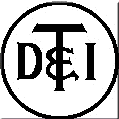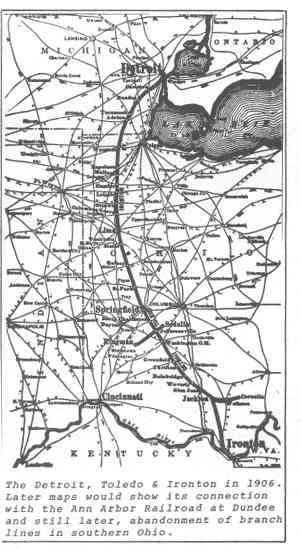- Details
- Hits: 3032
Railroad: Detroit, Toledo & Ironton railroad
The Detroit, Toledo & Ironton was a successor to six predecessor railroads (see below). By 1898, the railroad had reached Detroit (Delray area) and established a depot at West End Avenue, south of Fort Street. In the 1920's, the railroad was purchased by Henry Ford, who had a desire to controlling shipping in and out of the Ford Rouge works to dozens of intersecting carriers south of Detroit. Ford was frustrated by federal regulation and sold the line to Pennsylvania railroad interests about ten years later.
In recent years, the DT&I was sold to the Grand Trunk Western (now CN) and parted out to the Indiana & Ohio railroad south of Diann (Dundee). The I&O is a unit of the Genesee and Wyoming railroad.
Detroit Southern → Detroit, Toledo & Ironton Railroad → Grand Trunk Western
Began: 1905 as DT&I
Operated for 78 years.
Became: GTW in 1983
Reference: [MRRC]

 Notes
Notes
Throughout its life, this railroad was owned or controlled by many entities. The original line was from Ohio north to the Delray area via Adrian, Tecumseh and Trenton.
At one time or another, this railroad was owned or controlled by the Ann Arbor, Henry Ford, Pennroad (Pennsylvania RR), and Wabash railroads. After a period of GTW ownership, it was folded into the Canadian National Ry., then much of it south of Diann, MI was spun off to the Indiana and Ohio Railway (IORY), a unit of Rail America, which was later purchased by Genesee & Wyoming in 2012. The G&W has trackage rights east from Diann to Flat Rock.
For a period of time in the 1920's and 30's, the railroad was owned by Henry Ford for the purpose of bringing in raw materials to the massive Ford Rouge complex in Dearborn. Ford quickly tired of the regulation of the line and sold it at a profit to Pennroad, a subsidiary of the Pennsylvania railroad.
Video
Click Here: Early DT&I In Southern Ohio
Click Here: Riding the DT&I in the 1920's
1914. The DT&I constructs a new 5-stall roundhouse at Delray. [RR-1915-0220:260]
April, 1915: A collision in Detroit between a DT&I train and trolley car on the West Jefferson line kills 15 people. [NYT-1915-0415]
1920. April. DT&I awards a contract to build their new bascule bridge over the Rouge River in River Route. (Short Cut canal) [RR-1920-0925:491]
1920. The Detroit Toledo & Ironton serves 10 industries with 23 sidings and a car capacity of 288 cars. The have 3 sets of team tracks which hold 75 cars and 1 freight house. [DWT-1920]
1920. As a part of its electrification process, the DT&I constructed catenary poles and wires above six tracks in Rougemere Yard, north and south of the Eagle Street underpass. This was for interchange purposes with the PM but likely never used as the project was abandoned.
1921: January. The railroad purchases land at Flat Rock for use as a yard. [RR-1921-0108:76]
1921: June. The DT&I increases the minimum wage for employees to $6 per day. [NYT-1921-0609:18] They were the only railroad in the U.S. exempt from a strike call by railroaders. [NYT-1921-1016:2]
1921. July. The DT&I abolishes all Sunday trains, except for milk trains. [NYT-1921-0719:19]
1921. July. Henry Ford has cut the rates on his railroad which runs from Detroit through Ohio to the coal fields. A short time ago he made the minimum pay on this road $6 per day. If Henry makes both ends meet on his new rate and wage scale it will make some of the big wigs in railroad circles pucker up their lips. [DD-1901-0723]
1921: December. The DT&I lays off 150 employees. [NYT-1921-1202:19]
1923: May. The railroad also announces construction of a 14 mile branch to connect Flat Rock with the Ford Motor Co. plant at River Rouge. This will be a double track branch. [RR-1923-0505:786]
1923: August. Westinghouse Electric and Manufacturing will receive a contract with the DT&I to electrify the line, from the Rouge works to Flat Rock and beyond. [NYT-1923-0808:18]
1923: October. The ICC approves an investment plan by the DT&I to grant partial ownership to employees. Employees receive checks. [RA-1923-1020:725]
1923. December 5. The police of Springwells, a suburb of Detroit, armed with sawed off shot guns and riot guns, were called to disperse a crowd of 150 section workers at the DT&I railway at the Ford River Rouge blast plant when the laborers refused to go to work after a disagreement with officials over their time. The men gathered in front of the office and many angry voices were raised. Some one started to throw stones and within a twinkling of an eye, a general barrage of stones was directed at the office. A riot call was sent in to the Springwells police. When six officers arrived they found the men appeased by company officials and willing to return to their homes. [LSJ-1923-1205]
1924: May 24. The DT&I roundhouse at Detroit (Delray) is destroyed by fire. RR-1924-0308:483]
1924: July 15. The DT&I begins construction of the road's first electric locomotive in the Ford Rouge shops. These will be the most powerful and longest locomotives in the world. [RR-1924-0628][NYT-1925-0810:23]
1924: August. The DT&I is given permission to construct a 5 mile cut off from Durban, MI to Malinta, OH. The cutoff is reported to be a straight track. [RR-1924-0809:227].
1924: September. The DT&I begins reclaiming old ties for the manufacture of charcoal. [RR-1924-0906:371]
1925: May. Henry Ford requests permission to transfer the DT&I to a new corporation, the Detroit & Ironton. [RR-1925-0509:872] At the request of minority stockholders, the ICC examiner recommends rejection of the request. [NYT-1926-0808:1]
1926: The DT&I awards a contract to construct the interlocking plant and tower at Diann. [RR-1926-0828].
1929: June. The DT&I is purchased by C. D. Barney & Company for an unknown buyer, believed to be Pennroad Corporation, a unit of the Pennsylvania railroad. [NYT-1929-0627:27-6]
1957. November. The DT&I removes tracks on their Tecumseh branch from Adrian to Sand Creek curve, and will use trackage rights over the Wabash. [MWR-1957-1006]
1963: January 2. The ICC approves control of the Ann Arbor railroad and the Manistique & Lake Superior railroad by the DT&I. [WSJ-1963-0102:10]
Bibliography
The following sources are utilized in this website. [SOURCE-YEAR-MMDD-PG]:
- [AAB| = All Aboard!, by Willis Dunbar, Eerdmans Publishing, Grand Rapids ©1969.
- [AAN] = Alpena Argus newspaper.
- [AARQJ] = American Association of Railroads Quiz Jr. pamphlet. © 1956
- [AATHA] = Ann Arbor Railroad Technical and Historical Association newsletter "The Double A"
- [AB] = Information provided at Michigan History Conference from Andrew Bailey, Port Huron, MI

